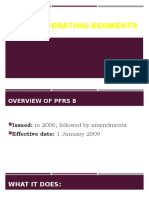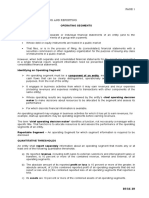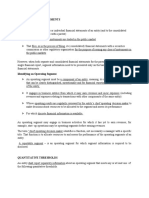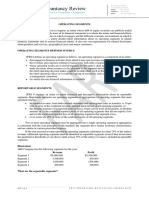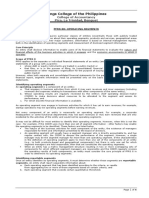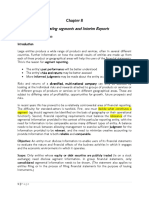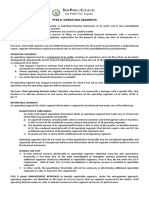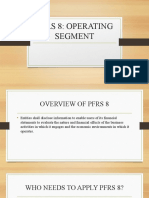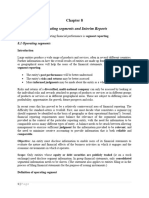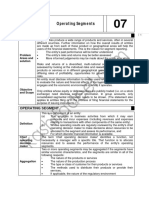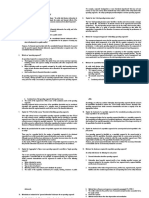100%(1)100% found this document useful (1 vote)
1K views24 pagesChapter 12 Operating Segment
Uploaded by
Kaith MendozaCopyright
© © All Rights Reserved
We take content rights seriously. If you suspect this is your content, claim it here.
Available Formats
Download as PDF or read online on Scribd
100%(1)100% found this document useful (1 vote)
1K views24 pagesChapter 12 Operating Segment
Uploaded by
Kaith MendozaCopyright
© © All Rights Reserved
We take content rights seriously. If you suspect this is your content, claim it here.
Available Formats
Download as PDF or read online on Scribd
You are on page 1/ 24
CHAPTER 12
OPERATING SEGMENT
Introduction
Globally, many diversified entities or entities operating in
several different industries have emerged.
Entities that previously operated in a single industry moved
into additional industries as a result of natural growth or by
acquiring other entities.
‘These entities diversified their operations for several reasons,
including the desire of management to spread the risks of
investment over a number of industries and product lines to
reduce dependence on any one set of suppliers and customers.
When an entity is diversified, the different industry segments
in effect operate as separate entities within an overall
corporate umbrella.
When a highly diversified entity presents only a total erttity
information, the results of operations and growth potential of major
operating segments cannot be analyzed and compared.
One product or geographical area may be performing well
and another product or geographical area may not be
Performing as well.
It becomes necessary to present not only a “total management
Performance" but also an "individual segment performance".
359
Scanned with CamScanner
Segment reporting
PERS 8 now sets out the requirements for disclosy,
information about operating segments. ‘closure of
‘The core principle of segment reporting is as follows:
“An entity shall disclose information to enable users of
financial statements to evaluate the nature and finan,
effects of the business activities in which it engages st
the economic environments in which it operates" “4
In accordance with the core principle of PFRS 8, segmen
reporting is the disclosure of certain financial informet4
about the ‘products and services an entity produces and the
geographical areas in which an entity operates.
‘The purpose of such disclosure is to enable investors and
users make better assessment of each business activity
leading to the understanding of the performance of the entity
as a whole.
Scope of PFRS 8
PFRS 8 shall apply to the separate or individual financial
statements of an entity, and to the consolidated financial
statements of a group with a parent:
a. Whose debt or equity instruments are traded in a public
market,
b. That files or is in the process of filing the consolidated
financial statements with a securities commission or
other regulatory organization for the purpose of issuing
any class of instruments in a public market.
However, if a financial report contains both the consolidated
financial statements of a parent and the parent's separate
financial statements, segment information is required only
in the consolidated financial statements.
360
oe ee
operating segment
gn operating se8ment i a component of an entity
‘phat engages in business activities fro
a Tyenue and incur expenses, ine}
expenses relating to transactioy
of the same entity.
m which it may earn
including revenue and
's with other components
ee en
Mitty's chief operating decision maierer ened by the
to make decisions
bout resources to be allocated to the segmems gc
its performance. Segment and assess
«, And for which discrete financial information is availabe.
Accordingly, an operating segment can generally be thought
ofas a distinguishable component of an entity that is engaged
n business activities which generate revenue and inner
expenses.
Moreover, to be classified as an operating segment, separate
financial information must be available about the segment
and ils operating results shall be regularly reviewed by a chief
operating decision maker.
An operating segment may engage in business activities for
which it has yet to earn revenue.
For example, start-up operations may be operating
segments before earning revenue.
an entity is necessarily an operating
f an operating segment.
Not every
For example, corporate headquarters or some functional
departments that may not earn revenue or may earn revenue
that is incidental only to the activities of the entity would
hot be operating segments.
An entity's postemployment benefit plan is not also an
operating segment.
361
See ee ea
Scanned with CamScanner
ww
ion maker
jon maker" identifies
function and not necessarily a manager with a specific it,
‘This function is "to allocate resources to the segments ang
assess their performance’.
‘The chief operating decision maker may be the entity's chi
ve officer, chief operating officer or a at
executive directors depending on who within the organization
is responsible for the allocation of resources and assessing the
performance of operating segments.
Identifying operating segments
‘The "management approach is used in identifying operating
segments.
‘The management approach means that the operating
‘segments are identified on the basis of internal reports about
components of an entity that are regularly reviewed by
the chief operating decision maker in order to allocate
resources to the segment and to assess its performance.
In other words, operating segments are identified based on
the components of the entity that are considered to be
important for internal management reporting purposes.
A component of entity that sells primarily or exclusively to
other operating segments is included in the definition of an
operating segment if the entity is managed that way.
The idea is that the reporting of segment information is seen
through the "eyes of management" and users would wish to
see the business as the chief operating decision maker sees
it.
PFRS 8 has abandoned the “risks and rewards approach” of
identifying operations by business segments and
geographical segments.
362
peportable segments
entity shall report information
ao
about an
mat that meets any of the fol ee
lowing quantitative
it revenue, including both
‘the seemen ig both sales to external
ustomers and intersegment sales or tranafere ic 10ie
syore of the combined revenue, internal and enteriey or
all operating segments, q
4, The absolute amount of profit or loss of the segment is
* ‘10% or more of the greater in absolute amount of
a. Combined profit of all operating segments that
reported a profit.
b. Combined loss of all operating segments that reported
a loss.
3. The assets of the segment are 10% or more of the combined
assets of all operating segments.
Operating segments that do not meet any of the quantitative
thresholds may be considered reportable and separately
disclosed on a voluntary basis if management believes that
information about the segment would be useful to the users of
the financial statements.
363
Scanned with CamScanner
Mlustration
Revenue, profit or loss, and assets for each operating
are as follows: Segment
Revenue Profit (loss)
aos
an ii asnacalilt tron eoneliteety
Seqment S ——_j5,000,000 00.000 rg
Sermon: Began (2,000,000) | 900000
SeemensC Sen eno—‘'sun-000, 3.000008
SeementD ono) ¢ 100,000) _900. 000
ted
Sete one
Based on revenue, A, B and C are reportable segments because
revenue associated with each of these segments is at least
‘4,000,000 which is 10% of the total revenue of P40,000,000,
D and E are not reportable segments because revenue of such
segments is less than 10% of the total revenue.
Based on segment assets, A and B are reportable sogments
because assets of such segments are at least P4,500,000 which
is 10% of the total segment assets of P45,000,000.
C, D and E are not reportable segments because their assets
are less than 10% of the total segment assets.
Applying the criterion of 10% of profit or loss is somewhat
complicated because some segments have profit and others
have losses.
‘The profit must be combined and the losses must be combined to
determine which is greater between the two.
Profit Loss
A 1,700,000
B 500,000
9g 1,000,000
D 200,000
E
2,400,000
364
the total profit figure is greate;
use r than the total
seca¥ pp, 400,000 is the basis for identifying repertanis
ferent
ith profit or loss of P:
, segment with P of P240,000 or greater (10%
72,400,000) aqualifies as reportable segment Therefore A
C are identified as reportable segment un
criterion. ent under the profit
jon A, B and C are id
conclusion A, © identified as reportabl.
tn Tents. D and E are not reportable segments because they
go not mect any One of the 10% quantitative thresholds for
Grentifcation 98 reportable segment.
‘hus, D and E may be combined for reporting purposes. But A,
Band C, being reportable segments, shall be disclosed
separately’
overall size test - 75% threshold
Ifthe total external revenue of reportable operating segments
fonstitutes less than 75% of the entity external revenue,
tiiitional operating segments shall be identified as reportable
segments even if they do not meet the 10% quantitative
thresholds until at least 75% of the entity external revenue is
included in reportable segments.
Aggregation of segments
ting segments may be aggregated into a
t” if the segments have similar
the segments share a majority
e aggregation criteria:
4
© Type or class of customers
4. Marketing method or the method used to distribute the
product
©. The nature of the regulatory environment, for example,
banking, insurance or publie utility
365
Scanned with CamScanner
ee
Illustration
‘An entity has no intersegment sales and has the fat,
operating segments with their corresponding revenye: -™®
Segment Revenue Percentage
1 2,400,000 30%
2 1,600,000 2
3 1,200,000 18
4 720,000 ie
5 640,000, a
6 560,000 7
7 480,000 é
8 400,000, 5
8,000,000 100%
Based on the revenue criterion, the reportable segments are
segments 1, 2 and 8. The remaining segments are not
reportable.
Assume that the remaining segments did not also satisfy the
other criteria of *profit or loss” and "total assets".
‘The total external revenue of the reportable segments is as
follows:
Revenue Percentage
Segment 1 30%
2 20%
5 1s
3,200,000 “G5%
Observe that the total percentage of the reportable segments
is only 65%.
In this case, additional operating segments shall be identified
even if they do not meet any of the 10% quantitative
thresholds,
366
egation
ting segments
ax moe operatin may be aggregated into "
eye" threshold.
f
ever, the operating segments to be aggregated must he
a lar economic characteristics and share a majority of the
ant geresation criteria,
t Segments 7 and 8 have similar products, similar
process, similar marketing method and.
inder regulated environment. —
sgesume that
groduction
fperating ©
«cordingly, Segments 7 and 8 can be aggregated as “one
AMtrtable sogment” to achieve the 75% threshold
Segment 1 30%
Segment 2 20%
Segment 3 15%
Segments 7 and 8 (6% + 5%) 1%
ee
‘Thus, the remaining segments 4, 5 and 6 shall be considered
nut reportable and lumped in the "other segments" category.
it to the number of segments
‘There may be a practical limit to the number of reportable
segments to be disclosed separately by an entity beyond which
segment information may become too detailed.
Although no precise limit has been determined, as the number
increases above ten, the entity shall consider whether a
practical limit has been reached.
In other words, if the number of reportable segments
exceeds ten, it is likely that the information may become
too detailed and consequently lose its usefulness.
367
Scanned with CamScanner
Eye
Segment no longer reportable
IF the management judges that an operating segment identi
as a reportable segment in the immediately preceding par“d
is of continuing significance, information about the seyer'®!
shall continue to be reported separately in the current per”
even ifit no longer meets any ofthe 10% quantitative threspei
for reportability las
Segment becoming reportable
Iran operating segment is identified as a reportable segmene
in the current period in accordance with the 10% quantitat;:
thresholds, segment data for a prior period presented fe
comparative purposes shall be restated to reflect the nea,
reportable segment even if that segment did not satisfy any cy
the quantitative thresholds in the prior period
However, prior period segment information shall not be
restated if the necessary information is not available and the
cost to develop it would be excessive.
Information to be disclosed for each segment
An entity shalll disclose the following for each reportable
operating segment:
1. General information about the operating segment
2. Information about profit or loss, in: 8 Specified
revenue and expenses included in the measure of profit
or loss
ation about segment assets and segment
ies and the basis of measurement.
4. Reconciliations of the totals of segment revenue,
segment profit or loss, segment assets, segment liabilities
and other material segment items to corresponding items
in the entity's financial statements,
368
_gelosure about general information
bi
‘lose the follo
yy shall disc wing gener:
sjcing ements ali
a
actors used to identify the reportable segments
L
information about
le, whether management h,
cesar, tent has chosen to organiz
fhe entity around differences in produets ant see
geographical areas, regulatory environment, of a
ination of factors, and whether operating ott
ennaton fet 6 segments
of products and services from which each rey
at derives revenue. each reportable
tsample of disclosure about type of products and
services
anentity has three reportable operating segments, namely car
jars, motor vessels and software.
‘Te car parts segment produces replacement parts for sale
‘The motor vessels segment produces small motor vessels to
save the offshore oil industry and similar businesses,
‘Te software segment produces application software for sale
‘computer m cturers and retailers.
Disclosure cf profit or loss, assets and liabilities
Anentity shall disclose for each reportable segment a measure
ifprofit or loss, total assets and total liabilities.
An entity si ‘close a measure of profit or loss under
alleircumstances.
disclose a measure of total assets
ies for each reportable segment if such an
jmount is regularly provided to the chief operating
‘cision maker.
369
Scanned with CamScanner
ay
Profit or loss
‘An entity shall disclose the following if the speci
amounts are included in the measure of segment n°
or loss or otherwise regularly provided to the qntt
operating decision maker even if not included in the meat!
of segment profit or loss: Sure
1. Revenue from external customers
2 Revenue from transactions with other operat,
segments of the same entity ng
Interest revenue
Interest expense
Depreciation and amortization
Material items of income and expense as required by
paragraph 97 of PAS 1 y
7, The entity's interest in the profit or loss of associate and
joint venture accounted for by the equity method
Tneome tax expense
Material noncash items other than depreciation and
amortization
oreo
Note that interest revenue and interest expense must be
reported separately, unless a majority of the segment
revenue is from interest.
However, the chief operating decision maker relies primarily
on net interest revenue in assessing the performance of the
segment and in making decisions about resources to be
allocated to the segment.
Note also that the specified amounts are disclosed because
these are included in the measure of profit or loss
reviewed by the chief operating decision maker or otherwise
regularly provided to the chief operating decision
maker even if not included in the measure of profit or loss.
370
eae
segment revere and segment expense
* , g does not define any more so =
RS expense. fgment revenue and
ee
consequence, entities shall have a wide dis.
fa ming the Measurement ofthese items, ae
pas 8 simply states that the amount of segment revenue
S gment expense shall be the measure 1
ae ‘operating decision maker. ported to the
pe definition in the old standard may be of help
t revenue is revenue that is direct); il
segment at is directly attributable to
Segtment and the relevant portion of entity revenue that
4 spe allocated on a reasonable basis to the segment.
specifically, segment revenue includes sales to external
Sigomers and intersegment sales.
Segment expense is expense resulting from the operating
seuvities of the segment that is directly attributable to the
Segment and the portion of an expense that can be allocated
ona reasonable basis to the segment.
Segment assets
PERS 8 does not also define segment assets.
‘The amount of total assets disclosed for a reportable segment
shall be the measure reported to the chief operating decision
maker.
‘The old definition of segment assets may be of help.
Segment assets are those operating assets that are
employed by a segment in its operating activities that are
cither directly attributable to the segment or can be allocated
to the segment on a reasonable basis.
Examples of segment assets include current assets that are
wed in the operating activities of the segment, property,
Plant and equipment, intangible wssets and goodwill d:rectly
attributable to segment.
371
Scanned with CamScanner
Disclosure not required
PFRS 8, paragraph 24, provided that segment assets such
deferred tax assets, postemployment bencfit assets, finane.®
instruments, and rights arising under insurance contract
are not required to be disclosed. s
Specific information about segment assets
‘An entity shall disclose for each reportable segment the
following if the specified amounts are included in the
measure of total assets or if not included, are regulari
provided to the chief operating decision maker: a
1. The amount of investment in associate and joint venture
acoounted for by the equity method.
2. The amount of addition to noncurrent assets, other than
financial assets, deferred tax assets, postemployment
benefit assets, and rights arising under insurance contracts,
Segment liabilities
PFRS 8 does not also define segment lial
‘The amount of total liabilities disclosed for a reportable
segment shall be the measure reported to the chief operating
decision maker.
he
Segment liabilities are those liabilities that result from the
operating activities of a segment and that are either directly
attributable to the segment or can be allocated to the segment
on a reasonable basis.
‘The old definition of segment liabilities may be
Examples of segment liabilities include trade and other
payables, accrued liabilities, customer advances, pro
warranty liabilities and other claims relating to provision of
goods and services.
372
"sment profit or loss, total
entity provided the following financial information relating
of the reportable operating segments (amounts are
ws
oom
‘sumed
external
internal
ross profit,
Distabution costs
piministrative expenses
Doub accounts
Hoyee benefit expense
Enpieciation and amortization
Interest expense
Impairment loss
Profit or loss
60,000
8,000
t assets sold 5,000
20,000
re relating to the reportable operating
he following:
tization
t assets
Note that the amount for profit or loss is disclosed under all
reumstances
373
Scanned with CamScanner
ther items disclosed are specified in PFRS §
Feteen only because these are included in the me
profit or loss, measure of total assets and measure
liabilities reviewed by the chief operating decis
and are
a8UEE of
of total
on maker,
The impairment loss is disclosed because the amount ig
deemed material.
Reconciliations
‘An entity shall provide reconciliations of segment amounts
‘and amounts shown in the entity's financial statement related
to all of the following
1. The total revenue of all reportable segments to the entity
revenue.
2. The total profit or loss of all reportable segments to the
entity profit or loss before income tax expense and
discontinued operations.
3. The total assets of all reportable segments to the entity
total assets,
4. ‘The total liabilities of all reportable segments to the entity
total liabilities.
5. The total for every other material
disclosed by the reportable segments
corresponding amount for the entity,
Illustration
The Implementation Guidance 3 of PFRS 8 provided the
llowing suggested format for disclosing information about
reportable segment profit or loss, total assets and total
lial
In this illustration, the chief operating decision maker
decided not to allocate income tax expense to reportable
segments as a measure of profit or loss.
374
3
OF ity bas three reportable sogments, namely software
‘He Omics and car parts d
ut
other segments” which are not reportable include a small
sey busines, eaipment rental business and warehouse
{asin
suamounts are assumed
" Software Electronics Car parts Others Total
external 12,500 5.000 1,000 35,500
eee internal 000 ne
ft even 00 = = 3800
sponse 200 - 2 ho
300 110 > 3.000
4.100 500100 100
00 7000 2.000. 1,000
00 1.500 goo = 2900
16.000 24,000 4000200 4a 200
re following reconciliations are necessary:
Revenue
Jevenue of reportable segments 39,000
tevenue of nonreportable segments 1,000
Elimination of intersegment revenue 45500)
Enity revenue shown in income statement 35,500
Profit or loss
Profit orloss of reportable segments 4,000
Profit orloss of nonreportable segments 100
Bimination of intersegment profit (500)
ual
ion settlement received 500
Corporate expenses (189)
tity profit or loss shown in income statement 3,350
P
Beintersegment profit is the "gross profit” on intersegment
tales,
375
Scanned with CamScanner
~~
Total assets
Total assets of reportable segments 79,0
Total assets of nonreportable segments 200
Unallocated corporate assets ce
Entity total assets shown in statement of financial position 82.509
22.500
Total liabilities
‘Total liabilities of reportable segments: 44,00
‘Total liabilities of nonreportable segments md
Unallocated corporate liabilities 5.000
Entity total ancial position 49,99
Other materi
Interest revenue 150 3,950
Interest expense 2,700 100 2/800
Depreciation 3,000 - 3,000
Impairment loss 200 - 200
Expenditure for
noneurrent assets 2,900 1,000 3,900
The reconciling item to adjust expenditure for noncurrent
assets is the amount incurred for the corporate headquarters
building.
Change in internal organization
Ian entity changes the structure of the internal organization
in a manner that causes the composition of the reportable
segments to change, the corresponding information for earlier
periods, including interim periods, shall be restated.
However, no restatement is made if the corresponding
information for earlier periods is not available and the cost
to develop it would be excessive.
376
gmity-wide disclosures
in
disclosures" are additi i
ty-wide itional information that
d to be disclosed by all entities if such information ie
ded as part of the reportable segment information
require
ot POW
an entity shall disclose information about the following
4, Information about products and services
& Information about geographical areas
> jpformation about major customers,
povenue from products and services
an entity shall disclose the revenue from external
justomers for each product and serviee, or each group
Si eimilar products and services, unless the necessary
‘ormation is not available and the cost to develop it would
be excessive.
Revenue and assets from geographical areas
disclose the following geographical
An entit
information:
a Revenue from external customers in the entity's
ind in all foreign operations in total.
re of material revenue from external
lual foreign country.
buting revenue from external customers
instruments,
I . postemployment benefit assets and
ler insurance contracts, located in the entity's
Je and in all foreign countries in total.
country of
377
Scanned with CamScanner
y
Example of entity-wide disclosure
‘An example ofan entity-wie disclosure of information ay
geographical areas is as follows: nt
Revenue —_Noncurrent assets
Philippines 19,000 11,000
Japan 4,000 a
China 3,500 6,000,
USA 3,000 4,000
Other countries 6,000 3,000
Total 35,500 24,000
Major customer
‘A “major customer” is defined as a single external customer
providing revenue which amounts to 10% or more of an
entity's external revenue.
‘The following shall be considered a single customer:
a. A group of entities under a common control.
b. A government and entities under the control of such
government.
Disclosure about major customer
‘The major customer disclosure means that "an entity shall
Provide information about the extent of its reliance on its
major customers".
The entity shall disclose such fact of reliance on major
customers, the total amount of revenue from major
customers and the identity of the segment or segments
reporting the revenue. :
The entity is not required to disclose the identity of the
major customer or the amount of revenue that each segment
reports from that customer.
378
one
questions
_ wat i the core Principle of segment reporting?
briefly segment reporting.
B
4, What is the scope of PFRS 8?
s.pefine an operating segment,
«May the following be considered an operating segment?
a. Start-up operation
i Corporate headquarters
2 Postemployment benefit plan
1.Define a chief operating decision maker.
4.What are the quantitative thresholds in identifying
reportable segments?
10. Explain the "75% threshold” in identifying reportable
segments.
U.What are the criteria for aggregating two or more
segments into one reportable segment?
12s there a limit to the number of reportable segments?
13. Explain the treatment of the following?
& Segment that is no longer reportable in the current
in the immediately preceding
b. Segment that becomes reportable in the current period
but not reportable in the immediately preceding period
379
Scanned with CamScanner
> €
14. Enumerate the information to be disclosed f
reportable segment. OF each,
15, Explain the disclosure about general information
16. Explain the disclosure about profit or los,
s
reportable segment. {or each
17, What are the specified amounts included in the meng
asure
of profit or loss that are required to be disclosed?
18. Define segment revenue.
19. Define segment expense.
20. Define segment assets.
21. What are the segment assets that are specifically requis
to be disclosed? ee
22. Define segment liabilities
the disclosure about total assets and tot:
s for each reportable segment. ie
24. What reconciliations are required between segment
information and amounts shown in the entity's financial
statements?
25. What is the treatment of a change in internal organization?
26. What are “entity-wide" disclosures?
27. What is the entity-wide disclosure about products and
services?
28. Whats the entity-wide disclosure about geographical areas?
29, What is a "major customer"?
30. Explain the major customer disclosure.
380
pROBLEMS
problem 12-1 Multiple choice (PFRS 8)
what is the “core principle” of segment reporting?
1 An entity shall disclose significant financial
information by business segments act
ase geographi
An entity shall disclose information to enable user
to evaluate the nature and financial effects of the
business activities in which it engages and the
economic environments in which it operates,
a
be
a
2. See
gment reporting shall apply to
b. Consolidated financial statements of a group.
© Both the separate financial statements of an entity
and the consolidated financial statements of a group,
separate financial statements of an entity
lidated financial statements of a group.
3.Segment reporting shall apply to the separate finat
statements of an entity, and to the consolidated financial
statements of a group with a parent
y instruments are traded in a public
b ments are traded in a public market.
. process of filing the consolidated
statements with a securities commission for
.e of issuing any class of instruments in @
‘ket
4
381
Scanned with CamScanner
4.1f a financial report contains both the
financial statements of a parent and the pan
financial statements, segment information
consoli
ent’s se
is requ
a, The separate financial statements
b, The consolidated financial statements
e, Both the separate and consolidated 4
statements *nancial
4. Neither the separate nor the consolidated f,
statements nancial
5. An operating segment is a component of an entity
a, That engages in business activities from w1
hich it may
earn revenue and incur expenses, including raven!
and expenses relating to transactions with othe:
components of the same entity.
b. Whose operating results are regularly reviewed by
the entity's chief operating decision maker to make,
decisions about resources to be allocated to the
segment and assess segment performance.
c. For which discrete information is available.
d. All of these
6. Which may be considered an operating segment?
a. Start-up operation before earning revenue
b. Corporate headquarters
c. Functional department
d. Postemployment benefit plan
7. What is the approach prescribed in identifying an
operating segment?
Management approach
Operating approach
Enterprise approach
Segment approach
BO oR
382
date,
aa
' at
cee
8
9
what is the function of the chiot operating decision
maker?
4, To allocate resources to the
ss the performance of
p. To asses: of the operating segment:
users about operating segments
4. To allocate resources to the op.
assess their performance
operating segments
e.
erating segments and
Who could be the chief operating decision maker?
Chief operating officer
Chief executive officer
Group of executive directors
All those mentioned depending on who within the
organization is responsible for the allocation of
resources and assessing the performance of operating
segments.
pose
10.In financial reporting for operating segments, an entity
shall disclose all of the following, except
a. Types of products and services from which each
reportable segment derives revenue.
b. The title of the chief operating decision maker of each
reportable segment.
c. Factors used to identify the reportable segments.
4. The basis of measurement of segment profit or loss
and segment assets.
383
Scanned with CamScanner
~
Problem 12-2 Multiple choice (PFRS 8) 4 Pe
thre!
Cannot be considered reportable.
f May be considered reportable and separately disclosed
ating segments that do not meet any ofthe quantitative
olds
1. An entity shall disclose information about a;
operay
segment when ting
a
‘The segment external and internal reve:
more of the combined external re
operating segments.
ue i og
venue opt
if management believes that information about the
segment would be useful to the users of the financial
statements.
b, The segment external revenue is 10% oF more of, May be considered reportable and separately disclosed
combined external and internal revenue op ie © ‘Fthe information is for internal use
operating segments. I 4. May be considered reportable and separately disclosed
©. The segment external revenue is 10% or more of th if this is the practice within the economic environment
combined external revenue of all operating segments jn which the entity operates,
4. The segment external and internal reve
2. An entity shall disclose information about an
segment when the absolute amount of profit or I
a
"NUE 8 10% or
more ofthe combined external and internal reyeeg®
of all operating segments.
operating
loss is
10% or more of the combined profit or loss of al]
operating segments,
5, Whatis the quantitatve threshold for the revenue that must
be disclosed by reportable operating segments?
a, The total external and internal revenue of all reportable
segments is 75% or more of the entity external revenue.
b. The total external revenue of all reportable segments is
‘75% or more of entity external and internal revenue,
b, 10% or more of the combined profit of all operating c. The total external revenue of all reportable segments is
‘segments that reported a profit. 75% or more of the entity external revenue.
& 10% or more of the combined loss of all operating 4. The total internal revenue of all reportable segments is
a. jeuments that reported a loss 75% or more of the entity internal revenue.
segment when
10% or more of the greater between the combined profit
of all operating segments that reported profit ard
the combined loss of all operating segments that
disclose information about an operating
ting segments may be aggregated into
asingle ig segment if all ofthe following conditions
are satisfied, except
characteristics.
a majority of the nature of product
of production process, class of
asc thod of product distribution and
b. The mts ts of the segment are 10% or more of the ae ak
&- The nt aces oy erating Senta « is consistent with the core principle
enh weer of {he segment are 10% or more of the a agamon
assets of all operati
4. The assets of deed ot all operating segments,
4. The segments have dissimilar characteristics.
385
Scanned with CamScanner
oy
fig | PI
ple 12-3 Multiple choice (PFRS 8)
ro
tity shall disclose for each reportable segment
uve of all of the following, except jenenta
7. What is the treatment of an operating segment id
as reportable in the preceding period but it no ft
meets the quantitative threshold in the current otser Lie
a. The segment is no longer reported separately in i 6
current perio ‘ ul
Profi
th: The segiuant must ba reported: soperately ty g, Total assets if such amount is regularly provided to
c. The segment may be reported separately in the ey, ” the chief operating decision maker.
ere ‘Total liabilities if such amount is regularly provided
riod
4. The segment shall continue to be reported separ, © ‘to the chief operating decision maker
in the current period if management judgect Net assets
‘segment to be of continuing significance. the a
8, What is the treatment if an operating segment g.An entity shall disclose for each reportable segment all
identified as reportable in the current period but yi° f the following specified amounts included in the
reportable in the prior period? tok Sreasure of profit or loss, except
a. Prior segment data presented for comparat
purposes shall be restated to reflect the newt
eportable segment. ly
b, Prior segment data presented for compatative
a. Revenue from external customers
b. Revenue from transactions with other operating
segments of the same entity
purposes shall not be restated, «, Inrerest revenue
e. The'serment isnot reported separately in th eure ¢. Gain on disposal of investment
serio
4. Prict serment data presented for comparative An entity shall disclose for each reportable segment all
Tiinecessory, peepee cee sf the following specified amounts included in the
re of profit or loss, except
9. Which disclosure is required in relation to operating ett
Depreciation and amortization
segments? if
a, General information about the operating segment b. Interest expense
b, Information about segment profit or loss, segment c. Income tax expense
assets and segment liabilities d. General corporate expense
¢. Reconcihations of total segment revenue, total
segment profit or loss, total segment assets and total 1 disclose for each reportable segment which
segment liabilities to e8 4, An entity shall disclose fo pe
the entity's fnsretat ete egcomresponding amounts in of the following specified amounts that are included in
4. All of these 5 the measure of segment total assets?
10. An entity shall disclose which general information? 4. ‘The amount of investment in associate and joint
a. Factors used to identify the reportable segments venture accounted for by the equity method.
b. ‘Type of products and services b. Financial instrument
©. Change in the internal organization that causes the ©. Deferred tax assets
composition of the reportable segments to change 4d. Postemployment benefit assets
d. Factors used to identify the reportable segments and
type of products and services =
386 387
Scanned with CamScanner
ree cet :
5. Which of the following statements in relation to diseigy
of segment information is true? Ure
1. Ifanentity changes the way itis structured inte
so that its reportable segments change
comparative information for earlier periods
restated.
mally
+ the
St be
U. Disslosure is always required of the profit oF loss o¢
each reportable segment. °
Tonly
I only
Both I and IT
Neither I nor II
peoe
Which of the following statements in relation to
information about profit or loss of a reportable segment
is true?
1. The measurement of profit or loss to be disclosed for
each reportable segment is defined in PFRS 8,
IL. The profit or loss disclosed for a reportable segment
shall relate to the total assets attributed to that
segment.
Jonly
only
Both | and IT
Neither I nor II
Bese
. Entity-wide disclosures include all of the following,
except
Information about products and services
Information about geographical areas
Information about major customers
Information about intersegment sales
Bose
388
tion about geographical
informe areas includes all
Mowing, except is
4. Revenue from external customers
pb. Revenue from external customers
domicile and in all foreign oporety
Separate disclosure of material revenue from external
customers attributed to an individual foreign country.
4. Noneurrent assets located in the country of dows gs
and in all foreign countries in total
for each product
an the country of
ns in total.
e
q The ‘major customer” disclosure includes all of the
following, except
a. ‘The fact of the entity's reliance on major customers
b. The total amount of revenue from major customers
ec. The identity of the segment or segments reporting
the revenue from major customers,
4. The identities of the major customers
10.Which of the following statements in relation to major
customer disclosure is true?
ustomer is defined as one providing revenue
mounts to 19% or more of the combined
ie of alll operating segments.
tities of major customers need not be
disclose the total amount of revenue
ners and the identity of the segment
ue,
nents are true about major customer
389
Scanned with CamScanner
i
Problem 12-4 Multiple choice (IAA) |
pra
jem 12-5 Multiple choice (AICPA Adapted)
1, Segment revenue includes
a. Only sales to unaffiliated customers
b. Sales to unaffiliated customers and interse
sales.
c. Sales to unaffiliated customers and interest reve,
4. Sales to unaffiliated customers and other income®
ement,
2. An operating segment is a reportable segment if
a. The operating profit is 10% or more of the
Gporating probt of profitable segments, bined
b. ‘The operating loss is 10% or more of the combine
operating loss of segments that incurred an speratied
loss.
c. The absolute amount of segment operating pr
Jose is 10% or more of the combined operating nog
or loss.
d. None of these.
3. All of the following information about each operating
segment must be reported, except
a. Unusual items
b. Interest revenue
ec. Cost of goods sold
d. Depreciation expense
4. What is a reasonable upper limit for the number of
segments that an entity must disclose?
a. Two
b. Five
c. Six
d. Ten
5. In presenting segment information, for which of the
following must a reconciliation be provided?
Revenue
Operating profit or loss
Assets and liabilities
All of these
peep
390
a financial reporting for operating segments of an entity,
Ie Brent data ay be aggregated
ppefore performing the 10% tests if
aggregation criteria are met,
If the segments do not meet the 10%
bof the aggregation criteria ee
Before performing the 10% tests if all o
aggregation criteria are met ee ato he
4. If any one of the aggregation criteria is met.
7 majority of the
¢
‘an industry segment is a reportable segment if it is
‘gnificant to the entity as a whole. An industry segment
wetonsidered significant when any of the following
Snditions is met, except
a
a. Segment revenue is 10% or more of the combined
revenue of all of the entity's segments.
b, Segment assets are 10% or more of the combined
assets of all segments.
¢. Segment liabilities are 10% or more of the combined
liabilities of all segments.
4. Absolute value of a segment's operating profit or
operating loss is 10% or more of the combined
operating profit of all segments that did not incur an
operating loss.
3, An entity must disclose all of the following about each
reportable segment if the amounts are used by the chief
operating decision maker, except
a. Depreciation expense
b. Allocated expense
¢. Interest expense
‘tity-wide disclosures include disclosure about
a, Geographic areas
Geographic areas and allocated costs
Neither geographic areas nor allocated costs
391
Scanned with CamScanner
cow
Problem 12-6 Multiple choice (IFRS)
1. What is the definition of major customers?
a. Those customers that individually account for reye,
of 10% or more of the entity external revenue.“ "™Y°
b. Those customers that individually account for
of 10% or more of the external and internal revo
¢. ‘Those customers that individually account for rever =
of at least 90% of the entity external revenue. "“
4. Those customers who have been dealing with th,
entity for at least 5 years. e
Tevenue
2. A group is organized into a number of business divisions
across the world. The group has two main classes of
business, namely insurance and banking. The chief
operating decision maker receives information from each
business division on a quarterly basis and wishes to
report segmental information on the basis of these
divisions. What should be the basis of the reporting of
the segmental information?
a, The worldwide business divisions
b. The classes of business
¢. The entity should make full disclosure on the basis of
the worldwide divisions and the classes of business.
d. It would depend on the chief operating decision maker
but is likely to be the different classes of business,
3. A chemical entity has no overseas sales and the entity
produces different products. The entity sells the products
to small businesses, larger national business and
multinational entities. Internal reports are reviewed by
the chief operating decision maker on this basis. What is
the segment reporting?
a. Disclose a single business segment.
b. Disclose information on three different sets of
customers,
¢. No segment disclosure is required.
d. Segment reporting is silent on this matter.
392
anentity is in the entertainment industry and organizes
4Miqoor concerts in four different areas of the would
ol North America, Australia and Japan, The entity
Borts 0 the board of directors on the basis of each of
{he four regions. The records show the profitability for
{aon of the four regions. The cincerts are of two types:
popular music and classical music. What is the
Prpropriate basis for segment reporting in this entity?
The segments shall be reported by class of business,
that is popular and classical music.
p, The segments shall be reported by region, so Australia
and Japan would be combined.
«, The segment information shall be reported as North
America and the rest of the world,
4. Segment information shall be reported for each of the
four different regions.
a
5 An entity is engaged in the manufacturing industry and
has recently purchased an 80% holding in a small financial
services group. This group does not meet any of the
threshold criteria for a reportable segment. Can the entity
disclose the financial services group as a separate
operating segment?
a. The fin ‘ervices group cannot be disclosed as a
separate ng segment.
b. An entity is allowed to disclose an operating segment
separately if management believes that information
about the segment would be useful to the users of the
financial statements.
disclose only 80% of the results and
financial services group.
4. The entity shall disclose segmental information on a
geographical basis.
393
Scanned with CamScanner
yblem 12-7 (AICPA, Adapted)
Prol
‘Timmy Company provided the following informati
relation to revenue ea!
current year:
rned by operating segments fore
Intersegment
sales Total
Segment me
3,000 8,000
3a 4000 12°00
a 4,00
Combined 60,000 23,000 83,000
Elimination = 23,000) (23,000)
Consolidated 60,000 = 660,009
What total revenue should be disclosed by the reportable
segments?
a. 60,000
b. 83,000
d. 51,000
Problem 12-8 (AICPA Adapted)
Correy Company provided the following data relating to
operating segments:
Industry Revenue Profit ‘Total assets
10,000,000
=mpoe>
How many reportable segments does Correy have?
a, Three
b. Four
c. Five
d. Six
394
problem 12-9 (AICPA Adapted)
Company provided the folloy
aurmorating ‘segments: wing profit (loss) relating
v
W
x
Y
5 ( 200,000)
what are the reportable segments based on profit or lose?
v, W, X and Y :
fv, Wand X
Wand W
§, v,W. X,Y and Z
problem 12-10 (IFRS)
Macbeth Company, an entity listed on a recognized stock
exchange, reports operating results from a Ni
geMon 0 the chief operating decision maker meriee
‘The segment information for the current year is as follows:
Revenue
Profit 3,675,000
en 1,700,000,
Number of employees 500
‘The entity's results for all of its segments in total are:
Revenue
Profit 0.000
Aseets 17,500,000
Number of employees 18,500
Which piece of information determines that the North
imerican division is a reportable segment?
a Revenue
». Profit
i Assets
Number of employees
395
Scanned with CamScanner
Problem 12-11 (AICPA)
Aris Company provided the following information in rela,
to operating divisions for the current year: tion
Sales to unaffiliated customers 20,
Tntersegment cales of products similar to those sold 000,009
tounaffiliated customers fe
Interest eacnedonloanstoother industry cegments 0
‘The entity and all of its divisions are engaged solely
manufacturing operations. Under the revenue test, wha,”
the minimum revenue of a reportable segment? is
2,640,000
2,600,000
2,040,000
2,000,000
Problem 12-12 (AICPA Adapted)
Grum Company is subject to the requirements of sogmen,
reporting. In the income statement for the current year, the
entity reported revenue of P50,000,000 excluding
intersegment sales of P10,000,000, expe
and net income of P3,000,000. Expenses:
of P15,000,000. The combined total
segments at year-end amounted to P4
wyroll costs
ssets of all operating
000,000.
What is the minimum amount of sales to a major
customer?
a. 5,000,000
b. 4,000,000
. 6,000,000
4. 4,500,000
2 What is the minimum amount of external revenue to be
disclosed by reportable segments?
a. 22,500,000
396
7
problem 1213 (AICPA Adapteg)
¢ Company discloses supplemen
8 Su tal o
Gif gain. The following informatgn erating seement
infra ea Hae
Sale
cgooal ales Traceable expenses
: 600,000
x 500,000
Y = 350,000
400,000 1,450,000
saaitional expenses, not included above, are as fllows:
rect segment expenses
inital administrative expenses O00
appropriate common expenses are allocated to se
paved on the ratio of segment’ sales to total sales Wren
Egmont Z's operating. profit?
‘a. 100,000
b. 130,000
ce. 160,000
d. 250,000
Problem 12-14 (AICPA Adapted)
Cley Company has three lines of business, each of which was
determined to be reportable segment. Sales aggregated
P7,500,000 in the current year, of which Segment One
contributed 40%. Traceable costs were P1,750,000 for
Segment One out of a total of P5,000,000 for the entity as a
whole. The et locates common costs of P1,500,000 based
igment's income before common costs to
income before common costs. What amount should
orted as operating profit for Segment One?
@. 1,250,000
6. 1,000,000
© 650,000
4 500,000
397
Scanned with CamScanner
ine
Problem 12:15 (AICPA Adapted)
Lovina Company provided the fellowing information fy
current year: 7
Segment Sales ‘Traceable expensey
Aye 5,000,000, 8,000,000,
Bee 4,000,000 2,500,000,
Coe 3,000,000 1,500,000
‘The entity reported indirect expenses of P2,000,000, go
corporate expenses of P1,000,000, interest expenye a
500,000 and income tax expense of P400,000. The interest
expense and income tax expense are regularly reviewed
the chief operating decision maker as a measure of profit 2
loss. Appropriate common expenses are allocated tg
segments based on sales. What is Segment Coe's prof ¢°
the current year?
a. 775,000
b. 525,000
¢. 875,000
d. 900,000
Problem 12-16 (AICPA Adapted)
Hyde Company has three reportable segments. Common
costs are appropriately allocated on the basis of sales. In the
current year, Segment A had sales of P3,000,000, which was
25% of Hyde's total sales, and had traceable costs of
1,900,000. In the current year, the entity incurred segment
costs of P500,000 that were not directly traceable to any of
the divisions. Segment A incurred interest expense of
‘P300,000 in the current year. Interest expense is included in
the measure of profit or loss. What amount should be reported
as Segment A's profit for the current year?
a. 875,000
b.
c
d
398
problem 12-17 (IAA)
1p Company operates in several different industries, Total
see
ba for the salty {etaled P 14,000,000, and total common,
salts amounted to P6,500,000 for the current yoor Pon
costenal reporting Purposes, the entity allocates comme,
inti pased on the ratio of a segment’s sales to total velar
nal information regarding the different segmonte
follows:
les Costs specific tothe segment
wont 1,100,000
2 1,000,000
: 1,300,000
: 880,000
7 400:000
hat is the operating profit of Segment 17
Problem 12-18 (AICPA Adapted)
‘Taylor Company assesses performance and makes operating
decisions using the following information for the reportable
segments:
Total revenue 7,680,000
Total profit and loss "406,000
‘The total profit and loss included intersegment profit of
P61,000. In addition, the entity has P5,000 of common costs
for the reportable segments that are not allocated in reports
provided to the chief operating decision maker. For purposes
of segment reporting, what amount should be reported as
segment profit?
340,000
4. 345,000
© 401,000
4 406,000
399
Scanned with CamScanner
Patt
Problem 12-19 (AA)
Diversity Company had total assets of P65.000,099
year-end and provided the following condensed ingot
statement for the current ye'
45,000,
Sales 009
Expenses Gages
Income before income tax 12,000,009
Income tax expense CBsggaee
Net income 2.
‘The entity has two reportable segments and has develope
the following related information:
SegmentA SegmentB Others
Sales 25,000,000 15,000,000 5,000,009
Segmentexpenses 18,000,000 9,000,000 4000'009
Segment assets 35,000,000 18,000,000 7,000,009
‘The total assets of P65,000,000 include general corporate
assets of P5,000,000.
The total segment expenses of P33,000,000 in
corporate expenses of P2,000,000.
de general
‘The chief operating decision maker does not al
tax as a measure of profit or loss,
Required:
1. Prepare the necessary disclosures for Di
in relation to operating segments.
2 Prepare the reconciliations between segment information
and amount shown in the entity's financia
400
ye
plesn 12-20 aaa)
pr
1 Company does business in several different industries,
conf? densed income statement for ti
‘he trent year is as follows: he entire entity for
ae
60,000,000
Jes 000,
Seat of goods sold (28,000,000)
ross income 32,000,000
sapere (14,000,000)
Fiprecation
parame tax EXPENSE
Netineome
entity has two major reportable segments, X and Y. An
‘ms ysis reveals that P1,000,000 of the total depreciation
tapense and P2,000,000 of the expenses are related to general
forporate activities,
‘The chief operating decision maker allocates income tax
expense to reportable segments as a measure of profit or
loss.
‘The expenses and sales are directly allocable to segment
activities according to the following percentages:
SegmentX SegmentY Others
Sales 40% 45% 15%
Cost of goods sold 35 50 8
Expenses 40 40 20
Depreciation 40 45 15
Income tax ex 50 40 10
Required:
1. Prepare a sch that reports the segment profit or
loss.
2 Prepare the disclosures required for operating segments.
3. Prepare t ‘ions between segment information
and amounts shown in the entity's financial statements.
401
Scanned with CamScanner
Hive
Problem 12-21 (IFRS)
Easy Company provided the following statement of fin,
position at year-end and income statement for the”
year:
ancial
‘Uurrent
Current assets 130,009
500,009
a 100,006
eel in associa oot
otal assets 800.000
Current liabilities 90,009
Noncurrent liebilities 60,000
Share capital 400,000
Retained earnings 250,009
Gross profit
Other income
Distribution cost
‘Administrative expenses
Other expenses
Finance cost
Share in profit of associate
Income before tax
Income tax expense
Net income
* The entity is organized for management purposes into
three major operating segments, namely furniture,
stationery and computer products. There are other
smaller operating segments.
Externalsales — Intersegment sales
Purniture 800,000 200,000
Stationery 500,000 150,000
Computer products 400,000 50,000
Other segments 100,000, =
402
Tapenses and finance cost
jrniture, 25% to stationery, 9
i jr to other segment” 20% to computer products
les related t
‘the cost of sal ‘0 intersegment sal
Tt.00 tobe alloc ae geet ant
stationery, and 10% to computer product
‘The segment assets and lial
ities are as follows:
Computer
Furniture Stationery products Others
nt assets 20,000 40,000 5,000 2,000
Property. plant and
100,000 85,000" 3,000
30.000 10,000 ie
170,000 100,000 5,000
30,000 8000 1,000
20.000 7,000 2.000
50.000 15,000 3,000
‘The remaining assets and liabilities are general corporate
assets and liabilities identified with the entity as a whole.
* ‘The other income and other expenses are not allocated
to the operating segments as a measure of profit or loss.
* The chief operating decision maker does not allocate
income tax expense to reportable segments as a measure
of profit or loss.
Required:
1. Determine the profit or loss for all of the operating
segments.
2 Prepare the disclosures required for operating segments.
3 Prepare the necessary reconciligtions between the
segment information and’amounts shown in the entity's
financial statements.
403
Scanned with CamScanner
a
Problem 12-22 (IAA)
Revlon Company provided the following data for the curr,
year. me
Segment Revenue Profit (loss) Agog
1 620,000 200,000 400,
2 100,000 20,000 30.000
3 340,000 70,000 300,000,
4 190,000 30,000) 140,000
5 180,000 25, 180,000
6 70,000 120,000,
7 120,000 140,000
Others 380,000 140,000
*. ‘The “others” category includes five operating segments,
none of which has revenue or assets greater than P80,009
and none with an operating profit.
*. Operating Segments 1 and 2 produce very similar
products and use very similar production processes, but
serve different customer types and use quite different
product distribution system. These differences are due
in part to the fact that Segment 2 operates in a regulated
environment while Segment 1 does not.
*. Operating Segments 6 and 7 have very similar products,
production processes, product di
are organized as separate divisions since they serve
substantially different types of customers. Neither
‘Segments 6 and 7 operate in a regulated environment.
Required:
1. Determine the reportable segments without regard to
aggregation criteria
2. If the 75% overall size test for reportable segments is not
yet met, identify additional reportable segments.
3, What are the reportable segments after considering all
factors?
404
problem 12-25 (IAA)
versal Company has two different
ves significant sales both in the Philippieee’, hee and
se entity has compiled the following information:
Product A,
iseett aces ProduetB
Phil
Philippines Japan
1,000,000 1,600,000
Retin profit or 108s 250,000 goq,9q “e008 2,000,000
Seton i000 2000 500.000 "200,000
Deeg plant and M 800,000 500,000
pment 500,000
“mopman fo2a% 00.600 2560000 1500.00
secoett 2 200,000 1,400,000 6.00000 scou.eee
ent liabilities 700,000 00,000
i r 000,000 2,000,000
Capital expenditures 200,000 400,000 1.000.000 son,000,
Required:
1, Universal Company has structured its operations:
internally into two divisions based on two products, A
and B. Prepare the disclosures required in relation to
operating segments.
Prepare the entity-wide disclosure about geographical
areas to conform with the requirement of segment
reporting.
405
Scanned with CamScanner
You might also like
- Pfrs 8: Operating Segments Scope PFRS 8 Applies To The Separate or Individual Financial Statements of An Entity (And To The ConsolidatedNo ratings yetPfrs 8: Operating Segments Scope PFRS 8 Applies To The Separate or Individual Financial Statements of An Entity (And To The Consolidated4 pages
- MODULE 7 SEGMENT REPORTING With Exercise ProblemNo ratings yetMODULE 7 SEGMENT REPORTING With Exercise Problem4 pages
- Operating Segments: Indian Accounting Standard (Ind AS) 108No ratings yetOperating Segments: Indian Accounting Standard (Ind AS) 10814 pages
- Pfrs 8 Operating Segments & Pas 34 Interim ReportingNo ratings yetPfrs 8 Operating Segments & Pas 34 Interim Reporting5 pages
- Ifrs 8 and Ias 34-Operating Segments & Interim ReportingNo ratings yetIfrs 8 and Ias 34-Operating Segments & Interim Reporting46 pages
- Ifrs 8 and Ias 34-Operating Segments & Interim ReportingNo ratings yetIfrs 8 and Ias 34-Operating Segments & Interim Reporting46 pages
- AcFN 3151 CH, 7 Segment Reporting and Interim Reporting IFRS 8 andNo ratings yetAcFN 3151 CH, 7 Segment Reporting and Interim Reporting IFRS 8 and42 pages
- 31 Pfrs 8 - Operating Segments: Scope 1. What Is The Scope of The Standards?No ratings yet31 Pfrs 8 - Operating Segments: Scope 1. What Is The Scope of The Standards?6 pages
- Chapter 13: Operating Segment Segment Reporting - Core PrincipleNo ratings yetChapter 13: Operating Segment Segment Reporting - Core Principle10 pages




